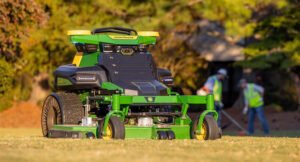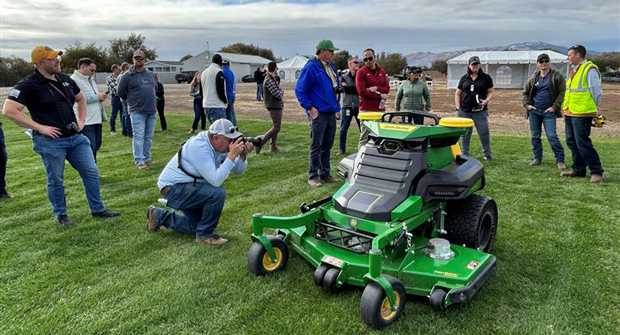At CES 2025 — the former Consumer Electronics Show that’s the largest trade show in America and is billed as the world’s most powerful tech event — companies such as Sony, Samsung, Google and Meta are used to stealing the headlines with their technological breakthroughs and cutting-edge new products.

But this week in Las Vegas, those companies had to share the spotlight with another big name, one that will be very familiar to those in the landscape industry but not generally associated with an event like CES: John Deere.
The company’s unveiling of a second-generation autonomous kit and several machines outfitted with this new technology — including a battery-powered stand-on commercial mower — captured plenty of attention earlier this week at CES. It made news among the industry press, of course, but it also grabbed headlines on tech websites like Mashable and international news sites like Semafor.
The mower was one of four pieces of equipment on display at CES. There were also two pieces of farm equipment — the 9RX tractor used in large-scale agriculture applications and the 5ML orchard tractor used in air-blast spraying — and the 460 P-Tier articulated dump trick used in construction and quarries.
While the technology used in these autonomous applications is impressive (more on that later), John Deere officials will tell you there are more practical reasons for the company’s foray into robotics.
“At the core, this is about listening to customers and what challenges them and their businesses,” said Jahmy Hindman, chief technology officer at John Deere, during an exclusive interview with Landscape Management at an event in November that gave industry media a sneak peek at the new technology.
“There’s a common thread among all these industries … and that common thread is labor availability and not being able to find enough people qualified to do the work that they have to do. We really think that the technology stack (the core of the autonomous kit) that Deere has been working on for 20 years can come to bear and help solve that problem.
“It started three years ago with a tractor that was doing tillage work, and since then, we’ve been busy trying to take that technology and scale it out across these other applications.”
John Deere’s second-generation autonomy kit combines advanced computer vision, AI and cameras to help the machines navigate their environments. The prototype for the commercial mower, for example, has eight cameras positioned two across on the front, right, left and rear of the mower to give it a 360-degree view of its surroundings. The farm tractors, further along in their production journey, double up on those cameras and also have Lidar to power precision spraying.
Select machines will be autonomy-ready from the factory, and the second-generation perception system will be available as a retrofit kit for certain other machines, providing customers with multiple paths to adoption based on where they are in their technology journey.
The machines are managed via John Deere Operations Center Mobile, the company’s cloud-based platform. Through the app, the machine can be started once placed in the appropriate spot. Users also have access to live video, images, data and metrics, and the ability to adjust various factors like speed.
Hindman told LM that John Deere’s ability to scale this autonomous technology across the variety of industries the company serves was a big driver behind the investment in time and resources that has gone into its development.
“We’ve been working on that autonomous tillage solution … for about five years. Now, it took us half that time to stand up the second application and get it to the point of first customer contact. About half that much time again to get to the third application, which is the commercial mower prototype. So, this notion that we can take what we learned and developed in one application and push it through to other applications that aren’t always obvious applications to use it in is pretty compelling.”


